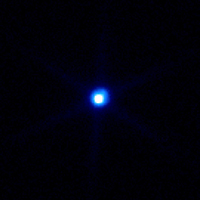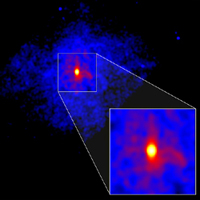April 10, 2002
RELEASE: 02-65
NASA's Chandra X-ray Observatory has found two stars -- one too small, one too cold -- that reveal cracks in our understanding of the structure of matter. These discoveries open a new window on nuclear physics, offering a link between the vast cosmos and its tiniest constituents.
Chandra's observations of RX J1856.5-3754 and 3C58 suggest that the matter in these stars is even denser than nuclear matter found on Earth. This raises the possibility these stars are composed of pure quarks or contain crystals of sub-nuclear particles that normally have only a fleeting existence following high-energy collisions.
By combining Chandra and Hubble Space Telescope data, astronomers found that RX J1856 radiates like a solid body with a temperature of 1.2 million degrees Fahrenheit (700,000 degrees Celsius) and has a diameter of about seven miles (11.3 kilometers). This size is too small to reconcile with standard models for neutron stars -- until now the most extreme form of matter known.
"Taken at face value, the combined observational evidence points to a star composed not of neutrons, but of quarks in a form known as strange quark matter," said Jeremy Drake of the Harvard-Smithsonian Center for Astrophysics (CfA) in Cambridge, Mass., and lead author of a paper on RX J1856 to appear in the June 20, 2002, issue of The Astrophysical Journal. "Quarks, thought to be the fundamental constituents of nuclear particles, have never been seen outside a nucleus in Earth-bound laboratories."
Observations by Chandra of 3C58 also yielded startling results. A team composed of Patrick Slane and Steven Murray, also of CfA, and David Helfand of Columbia University, New York, failed to detect the expected X-radiation from the hot surface of 3C58, a neutron star believed to have been created in an explosion witnessed by Chinese and Japanese astronomers in A.D. 1181. The team concluded that the star has a temperature of less than one million degrees Celsius, which is far below the predicted value.
"Our observations of 3C58 offer the first compelling test of models for how neutron stars cool, and the standard theory fails," said Helfand. "It appears that neutron stars aren't pure neutrons after all -- new forms of matter are required."
A teaspoonful of neutron-star material weighs a billion tons, as much as all the cars, trucks and buses on Earth. Its extraordinary density is equivalent to that of the nucleus of an atom with all the typical space between the atoms and their nuclei removed. An atom's nucleus is composed of positively charged protons and neutral neutrons, particles so small that 100 billion trillion of them would fit on the head of a pin.
Protons and neutrons are composed of even smaller particles called quarks, the basic building blocks of matter. Enormous atom-smashers are designed to probe the forces between quarks and the structure of the nucleus by smashing high-energy beams of nuclei into each other and observing the violent aftermath for a fraction of a second.
Drake cautioned that the observations of RXJ1856 could be interpreted as a more normal neutron star with a hot spot. Such a model is under consideration by Fred Walter of the State University of New York, Stony Brook, one of the discoverers of RXJ1856, which was originally found in 1996 by the German Roentgen satellite.
However, such a model would be expected to pulse, and a team of scientists lead by Scott Ransom of McGill University in Montreal, Canada report in The Astrophysical Journal Letters, that the pulsed fraction of the X-radiation from RX J1856 is less than 5%. To explain the absence of pulsations, a very special orientation with respect to the Earth is required.
"Regardless of how these mysteries are resolved, these precise observations are highly significant," said Michael Turner of the University of Chicago. "They demonstrate our ability to use the universe as a laboratory where we can study some of the most fundamental questions in physics."
NASA's Marshall Space Flight Center in Huntsville, Ala., manages the Chandra program, and TRW, Inc., Redondo Beach, Calif., is the prime contractor. The Smithsonian's Chandra X-ray Center controls science and flight operations from Cambridge, Mass.
MEDIA CONTACTS
Dolores Beasley
Headquarters, Washington
Phone: 202-358-1753
Steve Roy
Marshall Space Flight Center, Huntsville, AL
Phone: 256-544-6535
Megan Watzke
Chandra X-ray Observatory Center, CfA, Cambridge, MA
Phone: 617-496-7998




